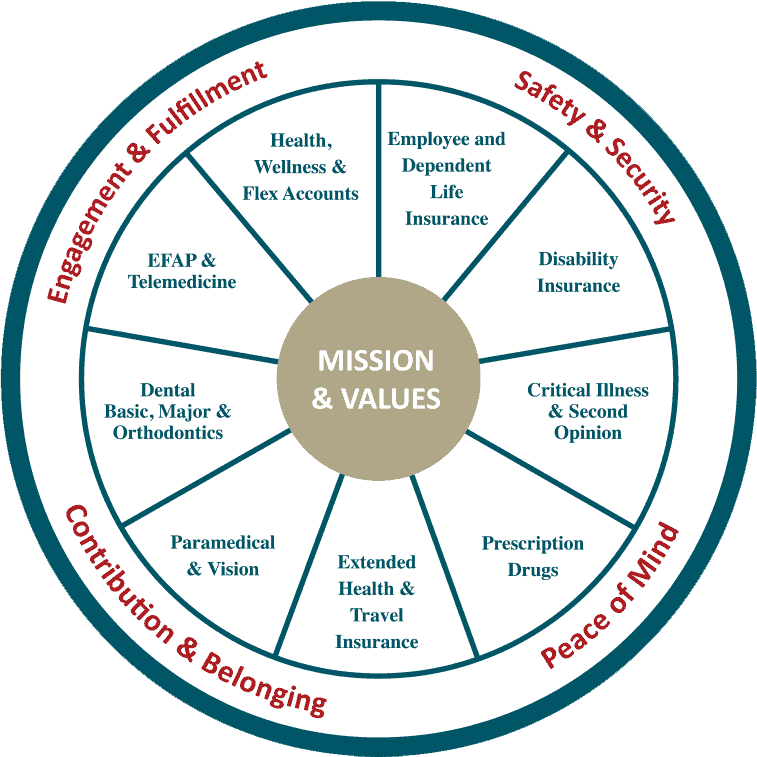I had it all together. I was strong. I was modelling all the good behaviours expected of a leader, showing no signs of stress or anxious moments. That’s the “me” I allowed my team to see. And as one of the owners and leaders of our company, I believed that was the best way to lead them, until the newest member of our team said something that made me re-evaluate and reflect on what strong leadership really looks like.
It was July 2020 and we had just finished phasing our team back into our office. The majority had been working from home, some in complete isolation. My partners and I had been having daily positive connections with our team and we frequently reminded them of the services in their benefits and pension plan, including our Employee Family Assistance Program (EFAP), for additional support. When we were all back together, we had a team debrief about the previous four months and provided a safe space for our team to ask questions and express concerns. Our newest employee’s comment humbled me. “I really struggled working from home,” she said. “You guys just seemed to have it all together. I don’t understand why I seem to be the only one struggling.”
I realized in that moment that my efforts to be strong for my team may have made them feel like it wasn’t safe to share their thoughts. I pondered whether my can-do attitude was diminishing my team.
“Nearly one-quarter [of survey respondents] … have considered leaving their current job due to their employer’s response to COVID-19.” “The most-reported reason … is increased mental stress/strain at work (53%).”1
I recently completed the Workplace Mental Health Leadership certificate program and learned that 77 per cent of Canadian employees report not feeling comfortable discussing a psychological health issue with their employer. Before now, the average utilization rate of EFAPs always puzzled me. For example, EFAP provider Homewood Health serves 9,000 organizations across Canada and has an average utilization rate of 11%. I expected usage to increase significantly over the past year. However, Homewood Health’s COVID-19 Utilization Trends of 2020 update reports that “when looking at the number of total cases in 2019 compared to 2020, overall service use was remarkably close, and on the whole was up 3% for all twelve months, compared to full calendar year in 2019.”2 Nobody can live a full life without experiencing some ups and downs. Not only are we all dealing with a global pandemic, but there are other life stressors, such as changes at work, the serious illness of a loved one, relationship struggles or financial uncertainty, just to name a few.
It makes sense, then, that in any given year, one in five people in Canada will personally experience a mental health problem or illness.3 And eight per cent of adults will experience major depression some time in their lives. Mental illness affects people of all ages, education levels, income brackets and cultures.
So why are EFAPs underused? I believe one contributing factor is leaders’ self-stigma — the shame or fear people have if they feel they are not “keeping it together.” That doesn’t apply only to mental health. Leaders need to create awareness about the accessibility of all our resources. It’s as simple as communicating the advantages of using the benefits the company provides — and talking about why they provide them. Dentists, telemedicine, financial planners, counsellors, paramedical practitioners: share them all. Leaders also need to share experiences to create a safe environment where they don’t have to “have it all together” or feel inadequate if they need to ask for help.
What are you offering to your employees to help them be their healthiest and most productive? Benefits and pension plans are the foundation of a total rewards package. Gone are the days when they were a perk. It has become a basic expectation for talent attraction and retention. But if you are treating it like just a box to check and you are not walking the talk, how much will it really count? Is your plan alone enough to make a meaningful difference in the lives of your employees? To your business? To you?
The Sutton Employee Benefits Wheel™

Question 1:
How would you rate your organization’s benefits plan in supporting your employees’ mental health?
You may point to the obvious benefits, such as an EFAP or a telemedicine provider. But look deeper. Do you provide flexibility for employees to attend health and wellness appointments or are they to be scheduled outside of business hours? Do you provide health and wellness spending accounts for employees to spend additional benefit dollars on what is meaningful to them? Are your annual maximums for paramedical practitioners and prescription drugs providing the necessary financial support? Do you ensure the benefit amount for life insurance provides employees with financial security and peace of mind?
Use our Sutton Employee Benefits Wheel™ to assess your satisfaction in each area of your organization’s current benefits plan. Consider how each segment helps or hinders your employees’ mental health. Score 0 — 10 in each area to see how balanced your wheel is.
Question 2:
How would you rate your own awareness and use of your organization’s benefits plan?
We might think we know our own plans well, but do you use, promote and advocate for the services it includes? It would be absurd if you had a toothache and neglected to see a dentist to get it taken care of. Are there areas on the wheel where you would just “suck it up” or “muscle through” if you needed assistance, instead of taking advantage of the benefits you provide? Have you called your EFAP provider for coaching or explored the resources available?
Question 3:
How well and how often are you communicating the message that you provide benefits out of care and concern for your employees?
Most organizations provide benefits to foster a feeling of security and to support a healthy and productive workforce. Most employers want their investment in benefits and pension to be meaningful. The underlying message — your care and concern for your employees can go a long way, especially when a benefits plan is designed intentionally and aligns with your company values. If it’s a one-size-fits-all plan that simply ticks a box, you are likely not getting the best value.
A common question (and frustration) I hear about benefits and pension plans is, “How do I get the most value from our benefits plan and then get employees more excited about them?”
Try this: Leaders need to use their benefits too and talk about their experiences. There is no way that average EFAP usage should be just over 10 per cent. Leaders must walk the talk. If leaders experience the full value of their benefits plan and share their stories, employees will feel it’s safe for them to follow. We do not want the message to be, “If you use your benefits, your costs will go up.” Not using what is being provided can have tremendous long-term costs in disability, health and dental claims, which ultimately hurts the business.
What preventive best practices can you incorporate in the following areas to support mental health?
- Reducing stigma.
- Managing stress.
- Supporting engagement.
- Building trust.
- Preventing distress.
- Promoting team spirit.
As a leader, you could be feeling ongoing stress from the demands of the business, feelings of uncertainty, and concern for the health and safety of your family and the well-being for all your employees. It is not easy. And we’ve all heard the “we’re all in this together” tag line. Although it’s nice to know we are not alone, we need somebody to lead the way. Strong leadership makes it safe for others, and it’s OK for leaders to get help too.
As for our EFAP, I used the counselling services for the first time in 2019. My spouse and I went for three in-person counselling sessions for parenting advice. They were invaluable. We acted on what we learned in those sessions with full participation from our children. We effectively reduced some stressors and everyone was happier at home. We had been investing in a business coach for years but did not appreciate the professional personal counselling we had available at our fingertips. Since then, other members of our team have followed suit, and our EFAP utilization rate is now 42 per cent.
As for our new employee, we celebrated her one-year anniversary and she is thriving in her career. She continues to have a positive influence on our culture. She has shared openly about her mental health journey, and that benefits us all. Her example reminds us that anyone can be a leader if they choose to be.
Let’s walk the talk. Together we are all stronger.
First published in the Spring/Summer 2021 issue of HR Saskatchewan Magazine.


